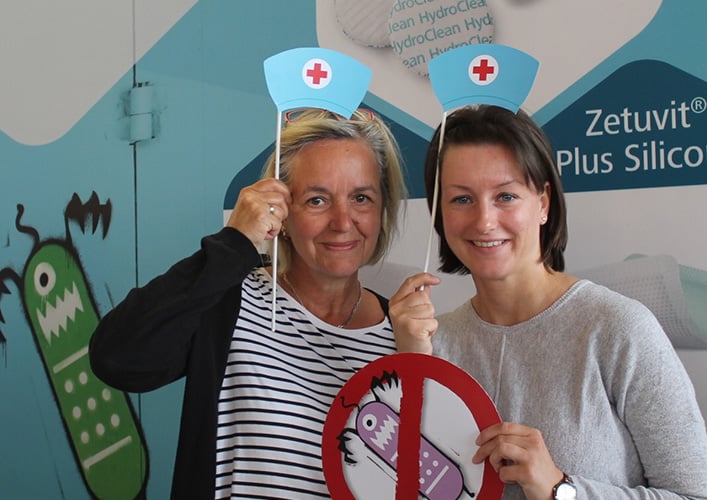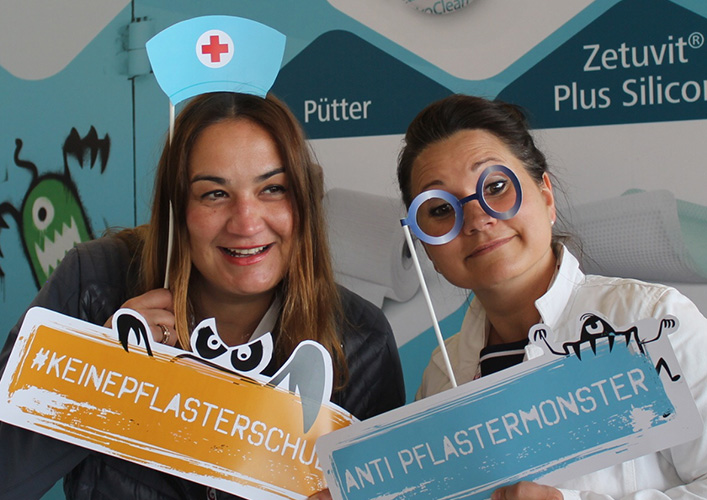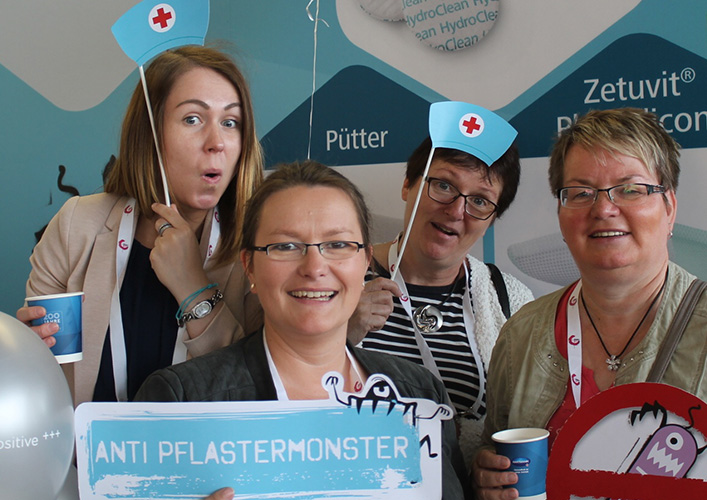Wir möchten uns bei allen Besuchern herzlich bedanken. Das Interesse an unserem Stand war dieses Jahr besonders groß und viele haben sich mit einem lustigen Schnappschuss in unserer Fotobox verewigt.
Unsere Neuheiten für Sie im Überblick
Hier finden Sie weitere Informationen über unsere Produktneuheiten im Bereich der modernen Wundbehandlung.
Zetuvit® Plus Silicone – Der erste atraumatische Superabsorber von HARTMANN.
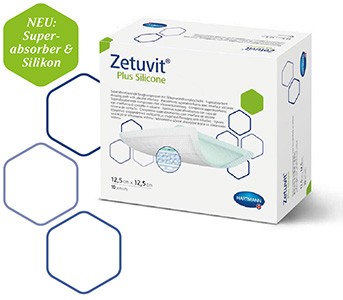
Vereint hervorragendes Exsudatmanagement mit einfacher und atraumatischer Wundversorgung [1-5]
- Effektiv: überlegene Leistung bei Absorption und Retention
- Sanft: schmerzarmer Verbandwechsel und angenehmer Tragekomfort [2,3,5]
- Einfach: Initial-Haftung für eine leichtere Fixierung der Wundauflage [2,3,5]
Vereinbaren Sie jetzt einen Beratungstermin: Tel. 0800 723 55 89
[2] Evaluierung von Resposorb Silicone 21062017.
[3] 165745-0002 _CER_ResposorbSilicone_Silicone Comfort_NAMSA_Final_31JAN2017.
[4] 150924 bilan perf prod V3 Vf. [5] Eine Fallstudie zur Evaluierung der superabsorbierenden Wundkompresse RespoSorb Silicone Dr. M.G. Rippon, S. Simm.
HydroClean® mini – Die hydroaktive Wundauflage mit dem einzigartigen Saug-Spül-Mechanismus. [1-4]
Für eine wirksame Wundreinigung und effektive Wundbettvorbereitung:
- Kleine Größe, große Wirkung: Wirksame Wundreinigung [1,3,14-17] und schnelles Débridement [1, 2,15,19-23], weniger Schmerzen während
der Tragezeit [2,15,16,19,20,22-26], deutliche Verringerung von Bakterienbelastung [1,2,27] und Biofilm [8] - Wirksam: Bis zu 69%-ige Entfernung von nekrotischen und abgestorbenem Gewebe innerhalb von 14 Tagen* [7]
- Einfach: Reinigung, Débridement, Entfernung von Fibrin, Exsudataufnahme, Bindung von Bakterien mit nur einer Wundauflage [1-4,14-18]
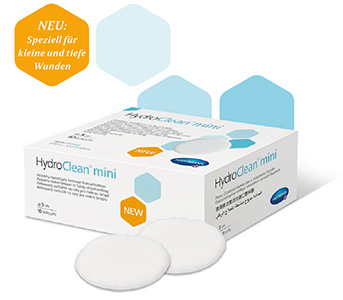
*Im Vergleich zum Behandlungsstart
[1] Atkin, L. and Ousey, K. (2016). Wound bed preparation: A novel approach using HydroTherapy. British Journal of Community Nursing 21 (Supplt. 12), pp. S23-S28.
[2] Ousey, K. et al. (2016). HydroTherapy Made Easy. Wounds UK 12(4).
[3] Humbert, P. et al. (2014). Protease-modulating polyacrylate-based hydrogel stimulates wound bed preparation in venous leg ulcers – a randomized controlled trial. Journal of the European Academy of Dermatology and Venereology 28(12), pp. 1742-1750.
[4] Smola, H. (2016). Simplified treatment options require high-performance dressings – from molecular mechanisms to intelligent dressing choices. EWMA 2016. Bremen, 11-13 May, 2016.
[5] Franks, P. et al. (2016). Management of patients with venous leg ulcer: challenges and current best practice. Journal of Wound Care 25 (Supplt. 6), pp. 1–67.
[6] Data on file(1).
[7] Hodgson, H. et al. (2017). A multicentre, clinical evaluation of a hydro-responsive wound dressing: the Glasgow experience. Journal of Wound Care 26(11), pp. 643-650.
[8] Davies L. et al. (2017). An Assessment of Biofilm Disruption and Bacteriostatic Capabilities of an Autolytic Debridement Dressing. Wounds UK Annual Conference. Harrogate, 13-15 November, 2017.
[9] Cooke, M. et al. (2017). Enabling wound healing and preventing limb amputation: a cost–benefit case study of Hydro-Responsive Wound Dressings. Journal of Wound Care 13(4), pp. 80-91.
[10] Hinchcliffe, R. et al. (2012). A systematic review of the effectiveness of revascularisation of the ulcerated foot in patients with diabetes and peripheral arterial disease. Diabetes/Metabolism Research and Reviews 28 (Supplt.1), pp. 179–217.
[11] Humbert, P. et al. on behalf of the CLEANSITE study group. Protease-modulating polyacrylate-based hydrogel stimulates wound bed preparation in venous leg ulcers a randomized controlled trial. Journal of the European Academy of Dermatology and Venereology 2014; 28:12, 1742-50.
[12] Kaspar, D. (2011). Therapeutic effectiveness, compatibility and handling in the daily routine of hospitals or physicians’s practices. HARTMANN Data on file: Hydro-Responsive Wound Dressing(HRWD) and AquaClear Technology are trademarks of HARTMANN
[13] Knestele, M (2004). The treatment of problematic wounds with HydroClean plus – tried and tested over many years in clinical practice. HARTMANN Data on file.
[14] Ousey, K. et al. (2016). Hydro‑Responsive Wound Dressings simplify T.I.M.E. wound management framework. British Journal of Community Nursing 21 (Supplt. 12), pp. S39-S49.
[15] Spruce, P. et al. (2016). Introducing HydroClean® plus for wound-bed preparation: a case series. Wounds International 7(1), pp. 26-32.
[16] Ousey, K. et al. (2016). HydroClean® plus: a new perspective to wound cleansing and debridement. Wounds UK 12(1), pp. 94-104.
[17] Atkin, L. and Rippon, M. (2016). Autolysis: mechanisms of action in the removal of devitalised tissue. British Journal of Nursing 25(20), pp. S40-S47.
[18] Kaspar, D. et al. (2015). Economic benefit of a polyacrylatebased hydrogel compared to an amorphous hydrogel in wound bed preparation of venous leg ulcers. Chronic Wound Care Management and Research 2, pp. 63-70.
[19] Bullough, L. et al. (2016). A multi-centre 15 patient evaluation of a Hydro-Responsive Wound Dressing (HRWD) - HydroClean® plus. HydroTherapy Symposium: A New Perspective on Wound Cleansing, Debridement and Healing. London, 3 March, 2016.
[20] Scherer, R. et al. (2015). HydroTherapy®. Application study. Heidenheim: Paul Hartmann AG. [Data on file].
[21] Chadwick, P. and Haycocks, S. (2016). The use of Hydro-Responsive Wound Dressing for wound bed preparation in patients with diabetes. Wounds UK Annual Conference. Harrogate, 14-16 November, 2016.
[22] Knowles, D. et al. (2016). HydroTherapy® wound healing of a post amputation site. Wounds UK Annual Conference. Harrogate, 14-16 November, 2016.
[23] Zollinger, C. et al. (2014). HydroTherapy®. Application Study. Heidenheim: Paul Hartmann AG. [Data on file].



